Holding on to customers is a top priority for most businesses. And it’s much easier to do that when you truly understand what your customers want and expect from your business.
Customer retention stats offer valuable insights into customer expectations, preferences, and behavior. They reveal the common factors that keep customers coming back and what tends to drive them away.
In this article, we’ll share 65 of the most important customer retention statistics.
The more you align your business strategies and services with these insights, the higher your chances of delivering a stellar customer experience and building a strong base of loyal, repeat buyers.
Key Takeaways
The customer retention statistics we’ll discuss below highlight several important points, including:
- Customer retention costs significantly less than acquiring new customers
- Existing customers tend to spend more (and more often) than new customers
- Improving customer experience is a major driver of customer loyalty
- A well-structured loyalty program can be highly effective at enhancing customer retention and increasing sales
- Customer retention rates vary significantly across different industries
With these important points in mind, let’s dive into the numbers.
General Customer Retention Statistics
The statistics below provide an overview of the costs involved in customer retention, and shed some light on repeat customer buying habits:
- Customer churn costs U.S. providers $168 billion per year (CallMiner)
- U.S. companies could save over $35 billion per year by focusing on keeping their existing customers happy (CallMiner)
- In 2013, ecommerce businesses paid an average of $9 to acquire a new customer. By 2022, this had risen to $29 (a 222% increase). (SimplicityDX)
- Businesses have a 60% to 70% chance of selling to an existing customer, while for a new prospect it’s just 5% to 20% (Forbes, quoting the book “Marketing Metrics”)
- Repeat customers spend 67% more than new customers (BIA Advisory Services)
- Some 52% of customers have gone out of their way to buy from their favorite brand (Zendesk)
- Two-fifths of companies place an equal focus on customer retention and acquisition (Invesp)
- As much as 44% of companies still don’t calculate their customer retention rate (CustomerGauge)
- Almost three-quarters of consumers feel loyalty towards a particular brand or company (Zendesk)
- Over 55% of consumers are loyal to a brand because they love the product (Yotpo)
- A third of consumers say it takes three purchases to create brand loyalty (Yotpo)
Impact of Customer Retention on Profits
Perhaps the most important impact customer retention can have on a business involves its profits. The statistics below illustrate the power of customer retention on a business’s bottom line:
- Some 84% of companies that work to improve customer experience notice an uplift in revenue (Dimension Data)
- Customer retention is vital for the 61% of small businesses that say over half their revenue comes from repeat customers (BIA Advisory Services)
- Small ecommerce businesses generate 35% of their revenue from the top 5% of loyal, repeat customers (Smile.io)
- After buying from your online store for the first time, a customer has a 27% chance of buying again. After a second purchase, there’s a 49% chance they’ll buy again. And after a third purchase, the likelihood increases to 62%. (Smile.io)
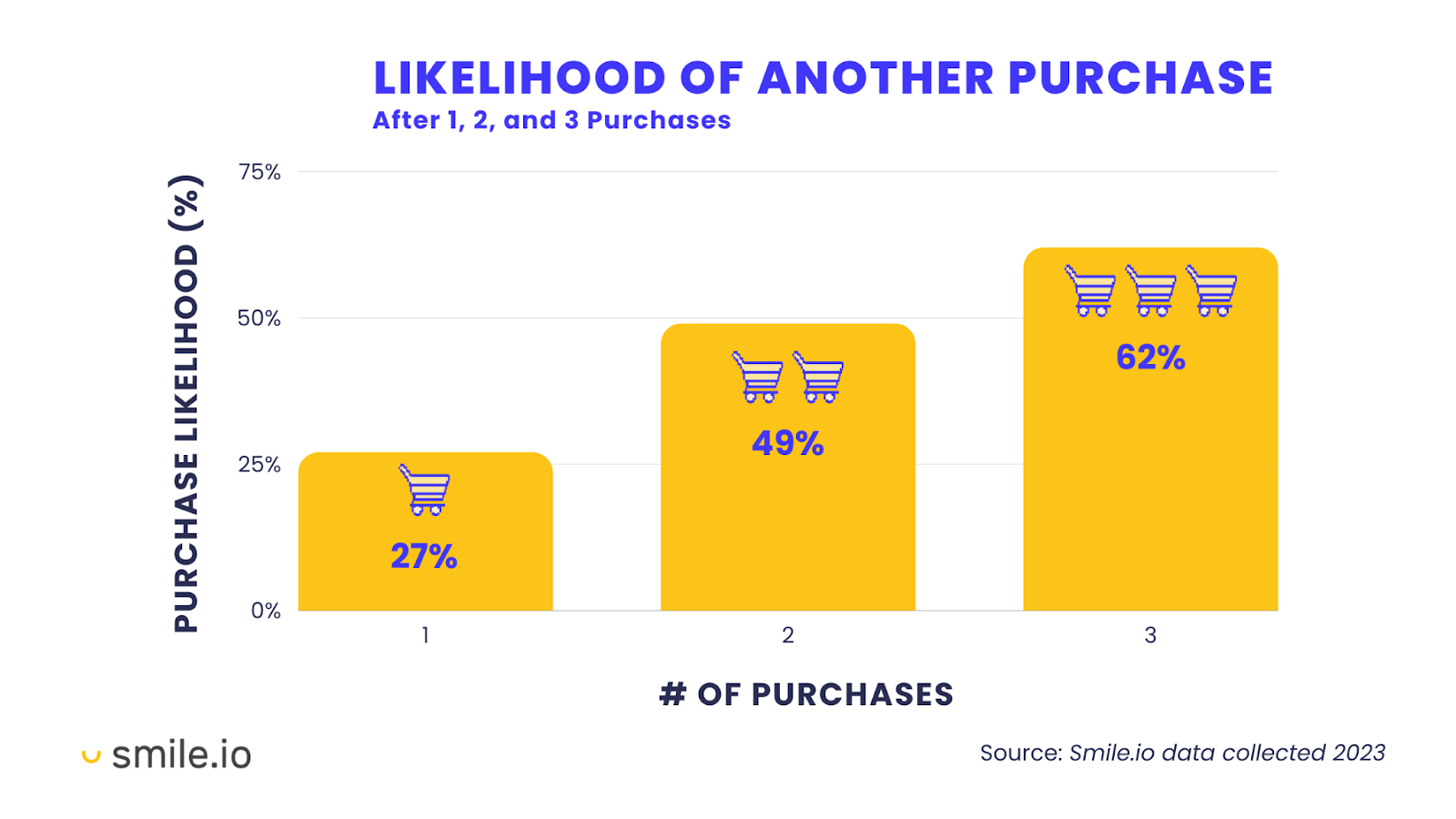
Image Source: Smile.io
- The longer customers buy from your business, the higher their average order value will be for most industries. For example, in the beauty and cosmetics industry, customers spend 30% more per order after shopping with a company for six months and 45% more after 36 months. (Smile.io)
- On average, your loyal top 10% of customers spend twice as much per order compared with your bottom 90% of customers (Smile.io)
- When it comes to word-of-mouth promotion, 60% of loyal customers will share their favorite brand with their friends and family (Yotpo)
- Over 39% of customers are willing to spend more with a brand they’re loyal to, even if there are cheaper options elsewhere (Yotpo)
Customer Loyalty Program Statistics
One method many companies use to retain customers is to implement a loyalty program. The data below shows the effect this can have on customer retention:
- In 2023, the global market size for loyalty management was $5.57 billion (Statista)
- The worldwide loyalty management market is forecast to reach $28.65 billion by 2030 (Fortune Business Insights)
- Between 2017 and 2019, 69% of C-suite executives reported increasing investment in customer loyalty programs (Business Wire, quoting LoyaltyOne's Big Picture Loyalty report)
- Over 71% of companies invest at least 2% of their total revenues into loyalty programs (Business Wire, quoting LoyaltyOne's Big Picture Loyalty report)
- Loyalty program members contribute to 43% of companies’ annual sales (Business Wire, quoting LoyaltyOne's Big Picture Loyalty report)
- Almost all companies (95%) say loyalty program members spend more than non-members each year. In fact, 60% of companies say loyalty program members spend two to three times more. (Business Wire, quoting LoyaltyOne's Big Picture Loyalty report)
- Loyalty programs can work well, with 79% of American consumers saying that participating in a loyalty program leads them to buy from a brand more frequently (Statista)
- Around 70% of U.S. consumers participating in a free or paid loyalty program say they spend more time with the brand as a result (Statista)
- While 76% of consumers say they don’t pay for the loyalty programs they participate in, 64% would be willing to do so in exchange for additional benefits like discounts and faster free shipping (Business Wire, quoting LoyaltyOne's Big Picture Loyalty report)
- Over 50% of companies are considering introducing fee-based loyalty programs (Business Wire, quoting LoyaltyOne's Big Picture Loyalty report)
- The average U.S. consumer belongs to more than 16 loyalty programs but actively uses less than half of them (Statista)
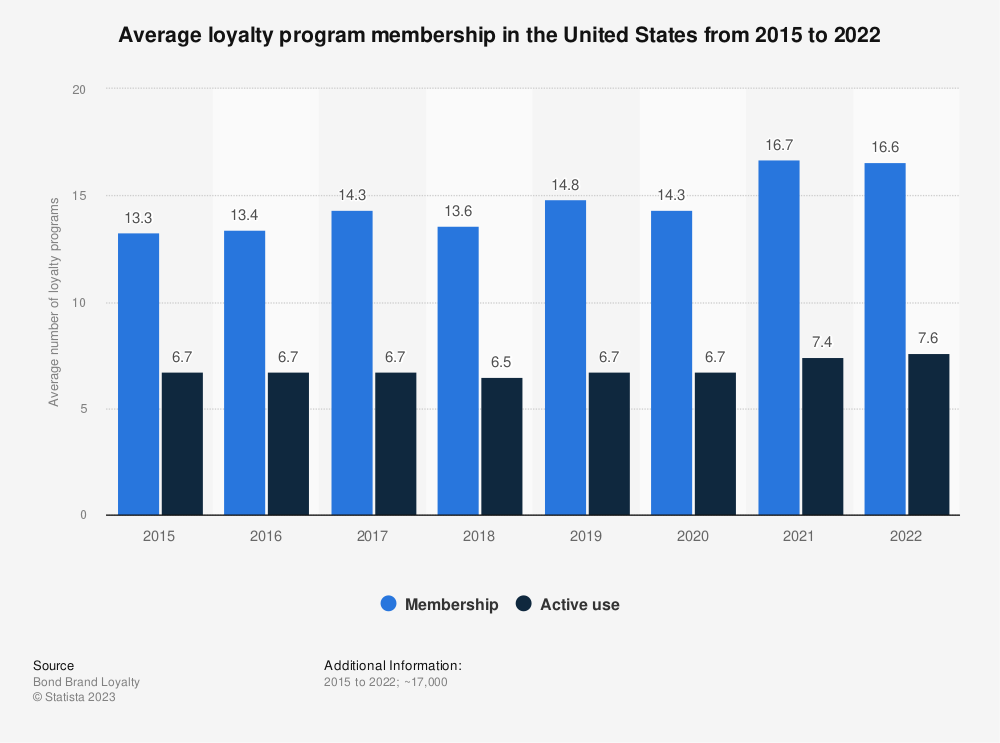
Image Source: Statista
- Over 50% of U.S. consumers are likely to increase their participation in loyalty programs (Statista)
- Almost 70% of paid loyalty program members cite free shipping as a key motivation for joining. Over 60% cite instant discounts as a key motivation. (Statista)
- Over 90% of executives in the U.S. believe their loyalty programs should provide customers with more rewards and benefits (Statista)
Customer Service Statistics
One of the most important factors that can impact customer retention is how your business handles customer service. See the statistics below to understand just how vital a positive customer experience can be:
- Over 90% of consumers think that a positive customer service experience makes them more likely to buy again (Salesforce)
- Around 83% of U.S. consumers believe good customer service is either an important or a critically important driver of brand loyalty (Statista)
- Some 58% of consumers say customer service is very important to their loyalty to a brand (Microsoft)
- Customers that receive “value enhancement” during service interactions have an 82% probability of staying with that company (Gartner)
- In 2021, 58% of customers said their expectations of customer service were higher than in 2020 (Talkdesk)
- Over 60% of customers believe the ability to resolve issues quickly is one of the most important aspects of a good customer service experience. Over 40% think the same thing about 24/7 support. (Zendesk)
- More than half of customers cite long hold times as one of the most frustrating aspects of a bad customer experience (Zendesk)
- Nearly 70% of customers are annoyed when their call gets transferred between departments (Zendesk)
- Around 44% of customers want businesses to ensure that customer service and support teams resolve their issues effectively and efficiently (CallMiner)
Differences in Customer Retention Across Demographics
The statistics below illustrate how different demographics feel about brand loyalty:
- Just under 60% of U.S. consumers say that once they are loyal to a brand, they will be loyal for life (Acquia)
- Three-quarters of U.S. consumers are more likely to be loyal if a brand understands them at a personal level (Acquia)
- Around 40% of millennials and Gen Z customers typically resolve issues with a company through messaging (Zendesk)
- Two-fifths of 16- to 34-year-olds are more likely to shop with an online retailer if they can track returns in one app, compared to just 33% of 45- to 54-year-olds and 25% of those over 55 (Klarna)
- Surveys show 46% of U.S. consumers, 40% of U.K. consumers, and 88% of Brazilian consumers have a more favorable view of brands that respond to questions and complaints on social media (Microsoft)
- During the COVID-19 pandemic, 21% of Gen Z consumers and 20% of millennials developed higher expectations for customer service interactions. Only 11% of consumers over 55 had the same increase in expectations. (Zendesk)
Customer Retention Behavior Statistics
Understanding customer behavior can show you what people prioritize when it comes to staying loyal to one company or another. The data below sheds light on the main reasons customers tend to stick or switch:
- A survey found that 31% of consumers have switched brands because a company was lying about product performance (YouGov)
- Poor customer service has caused 61% of consumers to switch brands (Microsoft)
- Almost 74% of consumers are likely to switch brands after a bad call center experience (CallMiner)
- About 50% of consumers would switch to a competitor after one bad customer experience. In the case of more than one bad experience, this increases to 80%. (Zendesk)
- Research shows that 62% of shoppers won’t buy from a retailer that doesn’t offer free returns. And 84% of shoppers won’t buy from the same retailer again after a poor returns experience. (Klarna)
- In 2020, 81% of consumers switched providers, despite only 63.9% planning to do so at the start of the year (CallMiner)
- Over 60% of consumers blamed high or increased prices for switching service providers in 2020, with 34.6% doing so because they felt they weren’t being treated fairly (CallMiner)
Average Customer Retention Rates by Industry
We have already discussed how demographics can impact customer retention. But it also varies by industry, as the data below shows:
- What is a good customer retention rate? The answer to this varies widely from one industry to the next. In 2018, media and professional services companies had the highest customer retention rates at 84%. The industry with the lowest retention rates was hospitality, travel and restaurants, with 55%. (Statista)
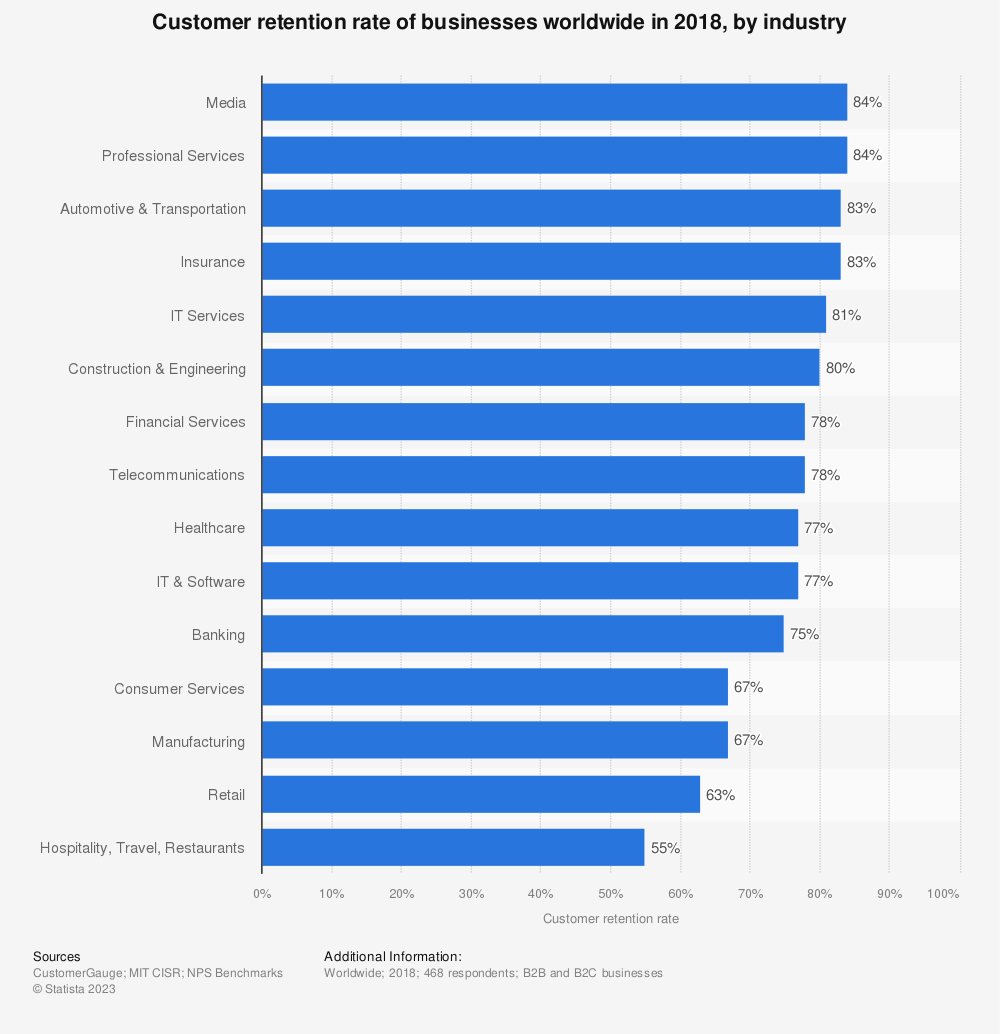
Image Source: Statista
- In 2023, 49% of customers were “extremely likely” to buy again from a supermarket brand they bought from in the last 90 days, compared to 25% for banks (XM Institute)
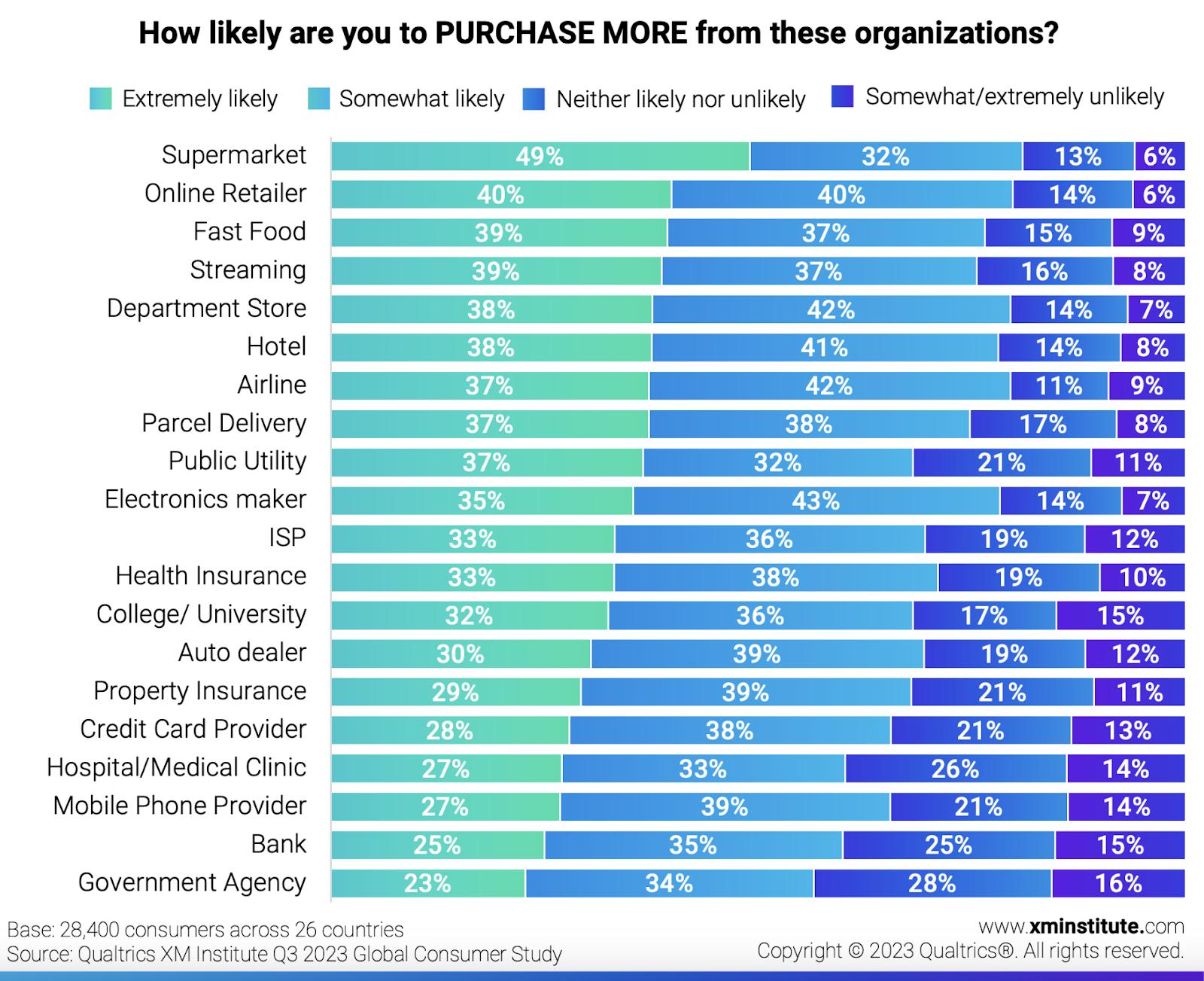
Image Source: XM Institute
- Most apps and software have a 6% to 20% eight-week retention rate (Mixpanel)
Online Channel Use for Customer Retention
The final piece of the customer retention puzzle is understanding the best ways to approach it. More specifically, which channels you should use. The data below outlines the most important ones to consider:
- Almost 90% of U.S. marketers use email for customer retention, 63% use social media engagement, and 55% use direct mail (Statista)
- Over 52% of consumers prefer to contact brands by telephone. Only 0.3% of consumers prefer to make contact by letter. (CallMiner)
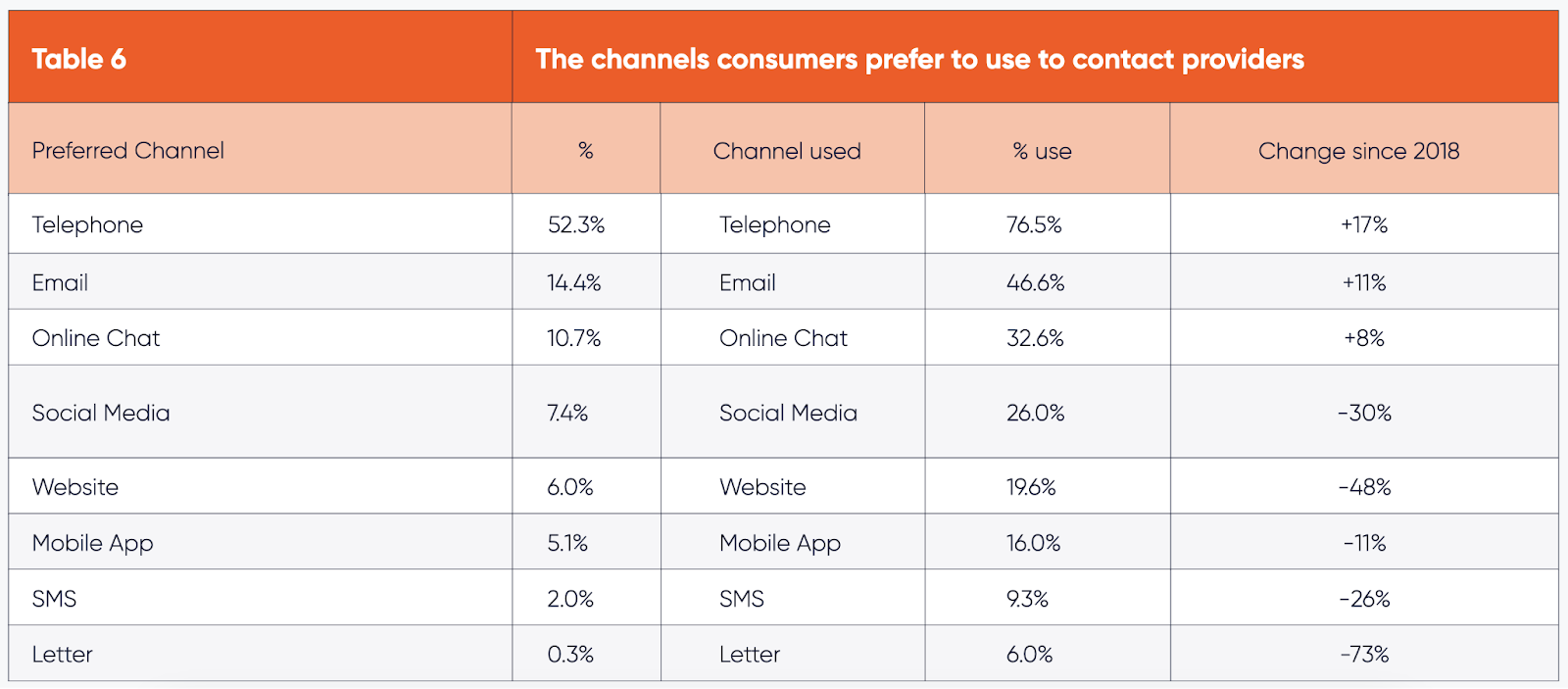
Image Source: CallMiner
- Just over 40% of marketers use their SEO efforts for customer retention (Statista)
- Customers spend between 20% and 40% more with brands that respond to customer service requests on social media (McKinsey)
- Half of customers pick a customer service channel based on how quickly they need a response (Zendesk)
- Almost 70% of customers want to resolve as many issues as they can on their own (Zendesk)
- Only 35% of companies adopt an omnichannel approach to customer service. And only 28% offer a knowledge base. (Zendesk)
Further reading: What Is Omnichannel? (+ Tips to Create Seamless Experiences)
Improve Your Customer Retention Metrics with Semrush
Focusing on customer retention isn’t some secondary growth hack—it’s a fundamental part of building a sustainable, profitable business.
Not only is it less expensive to retain existing customers than to acquire new ones, but happy and loyal customers are more likely to spend more and advocate for your brand.
But as the stats show, holding onto customers is no easy feat. It requires a dedicated approach with continual improvements.
Fortunately, tools like Semrush’s One2Target make it easy to build an accurate, detailed picture of your audience’s unique preferences. Helping you tailor your products, services, and marketing strategies to their specific needs.
Get more insights with a free trial.
